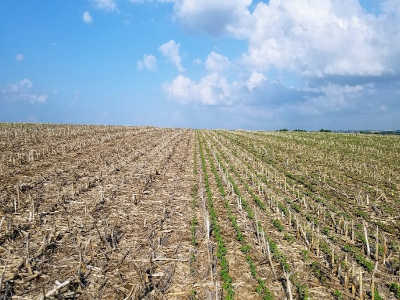By Laura Thompson
As you gear up for planting season, on-farm research can help you evaluate different soybean management practices. In 2019, four farmers evaluated practices that may contribute to increased soybean yields through a study with the Nebraska On-Farm Research Network. The studies examined planting date, seeding rate, and the use of foliar fungicides and insecticides. The practices evaluated a ‘baseline’ treatment, which was considered to be the conventional, standard practice, and an ‘improved’ treatment, which utilized practices that survey data found to be associated with higher yields.
- The baseline treatment consisted of a later planting date, higher seeding rate, and no foliar fungicide and insecticide treatment.
- The improved treatment consisted of an earlier planting date, lower seeding rate, and foliar fungicide and insecticide treatment.

Figure 2: Picture taken on May 27, 2019. Early planted soybeans from the improved soybean practice planted on April 20, next to strips that were about to be planted to evaluate the baseline soybean practice.
Brothers Larry and Lonnie Schafer, who farm corn and soybeans near Tobias, Nebraska, are one of the operations that evaluated these practices. This study was the first they conducted working in cooperation with the Nebraska On-Farm Research Network. For Lonnie, the interest in participating in this study stemmed from his desire to learn more about soybean planting date and seeding rates.
“We’ve always been curious about soybean planting dates and populations and this seemed like a good fit,” Lonnie explained.
Larry noted that the project did take some extra time to implement, but that his local extension educator, Randy Pryor, was available to help with plot design and data collection and that agriculture technologies made it easier to conduct the study. Larry and Lonnie plan to continue conducting on-farm research and suggest others may find value in participation as well.
“If people have a question about something or would like to see if something makes more yield or helps cost, I would encourage them to try it,” Larry said. “I’m sure it would help out in various ways.”
Lonnie agreed, suggesting other farmers participate in an on-farm research study and urging them to “keep an open mind.”
Early planted soybeans from the improved soybean practice
The results of the first year of the study were promising. Across four sites, the improved treatment resulted in an average 8 bu/ac yield increase and $46/ac profit increase compared to the baseline treatment.
The project is part of a larger, multi-state effort involving the University of Wisconsin, Ohio State University, Michigan State University, Iowa State University, North Dakota State University, University of Minnesota, and University of Nebraska.
View the entire, multi-state report.